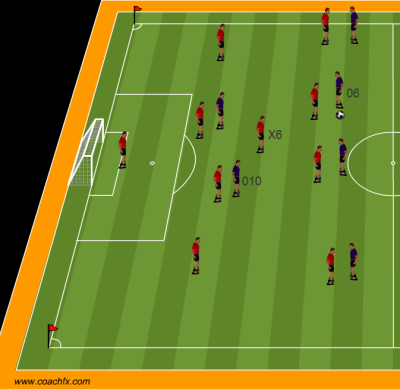4-5-1 Soccer Formation
The goal of soccer training is improved performance, injury prevention, soccer skills and tactics. Improved performance should never come at the cost of an injured player. Goal #1 is injury prevention in a soccer conditioning program. Goal #2 is to improve performance.
The 4-5-1 formation is an umbrella term used to describe what is actually 3 different formations. Each version of the 4-5-1 is designed for a specific purpose, with the concept of a true 4-5-1 with a lone striker and a flat 5 man midfield very rare in today’s game.
The 4-1-4-1 (Defensive)
The 4-1-4-1 is a defensively oriented version of the 4-5-1. The formation plays very similar to a 4-4-2 with the defensive midfield player acting as either a shield or a man marker. The man marking system would be used if an opposition player was causing problems floating in the grey area in front of the defense and behind the midfield. The extra defensive misfield can also look to act as a shield and cut off the supply of passes forward to the attackers.
Diagram A illustrates how this role is performed; (diagram a created with coachfx software)

In diagram A O6 has the ball and X8 provides pressure while also cutting out the possibility of a pass to O9. X6 is cutting out the pass to O10 forcing the team in possession to go sideways or even backwards, keeping the game in front of the defensive team.
The 4-4-1-1 (Attacking)
This formation provides an extra player in central midfield,
particularly in the attacking department. The two lines of four play in
the same manner as a traditional 4-4-2. The attacking midfielder, or
withdrawn forward can provide a numbers up mismatch anywhere along the
backline. Putting a creative player with good vision and awareness in
this position will make your team very effective and difficult to deal
with in attack. This floating forward is also referred to as a free role
and allows a player free movement when in position of the ball. A coach
using this formation should emphasize to the free player to stay high
and avoid the lone high forward becoming too isolated because the
floating forward goes too deep to collect possession. It should be
emphasized to the wingers to push up when the high forward is in
possession to avoid the striker becoming isolated in this formation.
When on defense, the floating forward should tackle back in this
formation and put pressure on any opposition midfielders in possession
of the ball. This can lead to double teams and turnovers. The floating
forward should also cut off the supply to any opposition midfielder
sitting and looking to be an easy get out pass backwards for his
teammates. When the floating forward tackles back it creates numbers up
for his in central midfield.
The 4-2-3-1 (Balanced)
The 4-2-3-1 is a well balanced formation that is becoming more popular in the elite European leagues. The formation deploys two holding midfielders who provide the spine of the team and play a key role in winning the possession battle. The two outside midfielder play high and wide and join the attack at pace. A central midfield player also plays in front of the shield provided by the 2 holding midfielders, this allows her to push high and play as a withdrawn forward when in possession. This formation has been used by teams who have a number of forwards among their best players. The defensive shield provided by the 2 holding midfielders allows more attack minded players to play in the midfield 3.
Strengths
- Back 4 covers the width of the field with good balance, allowing fullbacks to join the attack on overlapping runs.
- Two holding midfield players provide stability and defend against quick counter attacks.
- High wide midfielders offer good width to the attack.
- Numbers in midfield allow team to play for possession well, often with numbers up.
Weaknesses
- Lone forward can be isolated and lose possession.
- Midfielders can crowd the middle of the field if they do not move intelligently.
Requirements
High and wide midfielders must have pace to join the attack quickly. Wide midfielders must also have the ability to beat players off the dribble and provide quality crosses into the area. Forward must have physical strength and the ability to hold play up till numbers arrive in support.
